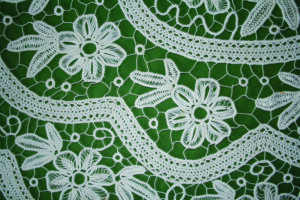(Editor’s note: DeeDee Wood is the owner of Black Cat Curiosities, an online antiques research and sales venue.)

There is a fascinating and complicated history of Irish lace, with vast techniques, regions and historic points of interest for Ireland and the people who created this needlework.
Lace is used in modern times for very specific purposes, such as wedding gowns, additions to clothing, banquet embellishments for tables and more.
There is a fascinating and complicated history of Irish lace, with vast techniques, regions and historic points of interest for Ireland and the people who created this needlework, where it was used for the same purpose as today’s lace creations, but with much more handmade needlework.
Lace from Ireland has always been a part of a broader tradition of needlework, completed mainly by girls or women.
Many of the rich traditions associated with Irish lace began in the 18th century, during a time when needlework was not a commercial venture, but, rather, a tradition.
Techniques and skills were passed down from generation to generation to create needlework lace, often called early crochet, depending upon technique, or lacework, needlework and more. It was named differently, according to techniques and finishing, and according to tools and knowledge used.
Lacemaking, especially in the 18th and 19th centuries, proved a way for women to help support their families with their crafting skills.
This type of needlework did not require a lot of equipment, and could be done in rural areas when trips to industrial factories would not work, or were geographically not advantageous. Bobbins, thread and sometimes needles were the only requirements to make the lace, over and over again.
Ironically, the wealthiest citizens of Europe wore the lace and used it in household décor, yet it was made by some of the most impoverished citizens of Ireland.
A luxury commodity, lace was promoted by aristocratic philanthropists, who were also involved in European distribution, establishments of schools teaching this varied needlework, promotion of the export business, and the establishment of careers for women who would normally not have a profit center.
This early establishment of lacemaking and the needlepoint industry prevented starvation and destitute living for hundreds of years in Ireland.
Aside from the lacework being taught in schools created by philanthropic efforts to promote better ways to earn wages and establish productivity and exports, during the Great Famine of the 1840s, nuns began schools in Ireland, as well, to teach students their knowledge of lacemaking and needlepoint.
Rooted in their knowledge in convents that taught needlework such as Venetian lace techniques, the schools provided successful ways to pass down this valuable knowledge and prevent starvation during tough times.
By the 1800s, there were a few factories in Ireland that hired many women to make lace, as well as handmade lace creations, in different regions.
The different types and techniques of “Irish lace” are vast, depending upon region, quality, technique and products used. Some of the most recognized types and techniques of Irish lace are Limerick lace, Kenmare lace, Irish needle lace and Carrickmacross lace, all with different origins, points, styles, bobbins, techniques and schools of thought.
Experts could tell the different depending upon region of export, subtle nuances in styles and manner, and the region from which the creation originated within Ireland.
Different buyers had their favorite regions from which the lace was produced, and knew the difference.
As styles changed and fashion moved on from heavy embellishment in the early 20th century, Irish lace went out of vogue.
It is still produced today, and techniques, regional creations, admiration and inclusion in some fancy clothing, (wedding gowns, for example,) keeps the spirit of Irish lace needlework alive for new generations.
The techniques, complicated regional subtleties, designs, tools and techniques used are all a rich historical point to a craft that saved a country from destitution and famine, all while preserving techniques passed down for hundreds of years in a country rich in needlepoint traditions.



